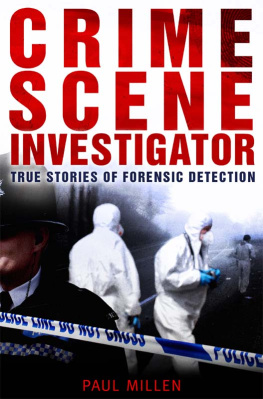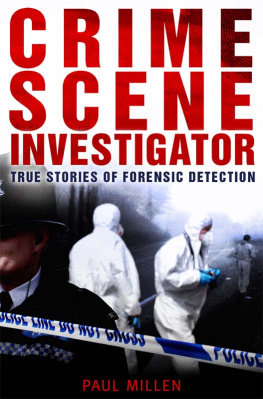
Becoming a Crime Scene Investigator
Jacqueline Detwiler-George
Master at Work
M ASTERS AT W ORK ALSO AVAILABLE
B ECOMING A N EUROSURGEON
B ECOMING A V ETERINARIAN
B ECOMING A V ENTURE C APITALIST
B ECOMING A H AIRSTYLIST
B ECOMING A R EAL E STATE A GENT
B ECOMING A M ARINE B IOLOGIST
B ECOMING AN E THICAL H ACKER
B ECOMING A L IFE C OACH
B ECOMING A Y OGA I NSTRUCTOR
B ECOMING A R ESTAURATEUR
B ECOMING A P RIVATE I NVESTIGATOR
B ECOMING A B AKER
B ECOMING A S OMMELIER
B ECOMING A C URATOR
B ECOMING AN A RCHITECT
B ECOMING A F ASHION D ESIGNER
B ECOMING A S PORTS A GENT
B ECOMING AN I NTERIOR D ESIGNER
B ECOMING A F IREFIGHTER
B ECOMING A N URSE
B ECOMING A V IDEO G AME D ESIGNER
B ECOMING A M IDWIFE
B ECOMING A T EACHER

Simon & Schuster
1230 Avenue of the Americas
New York, NY 10020
www.SimonandSchuster.com
Copyright 2021 by Simon & Schuster, Inc.
All rights reserved, including the right to reproduce this book or portions thereof in any form whatsoever. For information address Simon & Schuster Subsidiary Rights Department, 1230 Avenue of the Americas, New York, NY 10020.
First Simon & Schuster hardcover edition April 2021
SIMON & SCHUSTER and colophon are registered trademarks of Simon & Schuster, Inc.
For information about special discounts for bulk purchases, please contact Simon & Schuster Special Sales at 1-866-506-1949 or .
The Simon & Schuster Speakers Bureau can bring authors to your live event. For more information or to book an event, contact the Simon & Schuster Speakers Bureau at 1-866-248-3049 or visit our website at www.simonspeakers.com.
Illustrations by Donna Mehalko
Jacket design by Alison Forner
Jacket art by Stevy/iStock/Getty Images Plus
Library of Congress Cataloging-in-Publication Data has been applied for.
ISBN 978-1-9821-3989-6
ISBN 978-1-9821-3992-6 (ebook)
F OR THOSE WHOM JUSTICE DID NOT SERVE .
CUTTING
B ehind the convenience store, in full view of a broken surveillance camera, a camping chair and a blood-stained blanket sit abandoned in the urban blight. A pool of blood cools into gel on the sidewalk, separated from the rest of civilization by two fluttering lines of yellow crime scene tape. Past the police line, brick apartments squat on and on and on.
A passerby peeks over the tape. He got him three times in the back and once in the chest! he shouts.
But that is almost certainly not what happened.
What did happen behind this convenience store is, at this moment and legally speaking, a mystery. According to the dispatch call, it was a cutting, a police department term for what would colloquially be called a stabbing. Jill, a blunt, raspy-voiced officer for the Baltimore Police Department, arrived soon after it happened. She chased the suspect across the street, where she detained him. Then she walked back to the scene, hunting for witnesses. She found only one.
Back at headquarters, crime laboratory technician Erika Harden was just beginning her ten-hour shift. The call came through around five p.m., while she was prepping her equipment. Over the radio, Harden announced that she was 10-8, the code for in-service, then took the elevator down to the bay, a cavernous garage that acts as a staging area for the crime lab. She loaded her gear into a black, all-wheel-drive, midsize SUV marked FORENSICS , and headed into the literal sunset.
Over the millennia since the Cuneiform laws first codified rules of behavior for ancient civilizations in the Middle East, millions of people have been employed in an attempt to enforce them: Roman quaestors and Chinese prefects and Islamic muhtasibs; international tribunals and police departments equipped with military-style weaponry. Erika Harden represents the slickest, most postmodern moment in this historical procession. She is a professional crime solver who uses cutting-edge science to determine who is responsible for transgressions, so wrongdoers can be brought to justice and prevented from causing further harm. Using nothing but physical tools and logic, she travels backward through time, re-creating a crime in as much detail as a courtroom can stand.
This job has many names: crime scene investigator, evidence technician, forensic investigator, crime scene technician, crime scene analyst, and crime scene examiner among them. Technically, Harden is a Crime Laboratory Technician II, a title confusing enough that it has misled people into thinking it was a laboratory job. A more illustrative title is criminalist. Like a numismatist is a student and collector of coins, a criminalist is a student of criminalistics, a person who collects evidence in order to understand a crime in as much detail as possible. A criminalist should not be confused with a criminologist, which is a person who attempts to explain social deviance on a grand scale by plumbing the depths of psychology, policy, and punishment. A criminalist doesnt worry about the why of a crime. She deals in more prosaic questions: When? How? And most important, who?
E RIKA IS TWENTY - SEVEN , BUT appears younger, with kohl-rimmed eyes, plastic-gauged earrings, and a silver nose ring. She looks more like the lead singer in a punk band than a crime lab technician, which she has been for three years, ever since graduating from Stevenson University in Owings Mills, Maryland, with her masters degree in forensic science. She works ten hours a night, four nights a week, which sounds onerous but isnt really. The traffic is better at night than it is during the day, and shes used to late hours. In between school and starting at Baltimore PD, Harden worked shifts at a local bar.
Like many of her generation, Harden discovered crime scene investigation through the CBS show CSI, which catapulted the profession to fame after it premiered on October 6, 2000. Although its difficult to imagine after sixteen seasons and an unending series of sequels, spin-offs, and imitators, the general public knew next to nothing about criminalistics before CSI. For most of the professions history, crime scene investigators toiled behind-the-scenes in obscurity. People used to just fall into the job through a well-timed classified ad, the military, or friends and family who worked in law enforcement. Then came the show, which crime scene investigators in the younger age ranges almost universally claim as their first exposure to the career. For all its cheesy one-liners, CSI introduced the country to a job that rode the balance between law enforcement and hard science, where a smart nerd who lacked squeamishness could serve justice just as well as a hard-boiled detective in a fedora. It was
















